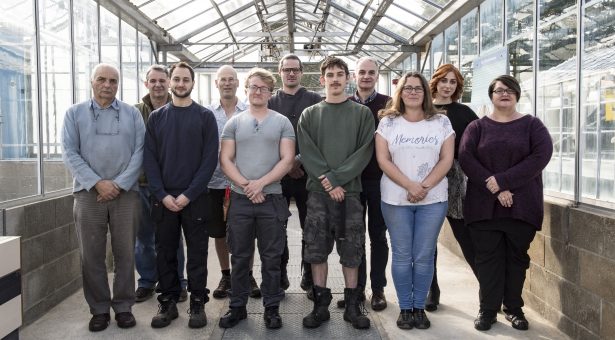Life in Horticultural Services

Alongside our field experimentation facilities, we also offer a full horticultural service, from potting up and growing plants, plus a range of glasshouses and Controlled Environment Rooms.
We asked team member and Instagram plant influencer, Sophie Able to enlighten us on what they can do to help plant scientists with their research.
“I am one of those people who loves their job and I am so lucky to share my passion for plants both at work and at home.
I think my love of plants developed at a very early age. I spent a lot of time with my Nanny in her garden before she passed away when I was still very young. My Mum is also extremely green fingered, so I have a lot of botanical childhood memories.
A few years ago, my passion for indoor gardening grew, I started by collecting succulents, but slowly found a love for all foliage. I’ve since developed a large house plant collection, which has proved popular on Instagram, you should definitely follow me to find out more…
I’m really proud to be part of the horticultural team we offer scientists here, because I’m not sure there are too many research institutes that offer the service we do. We invest a lot of time and effort in allowing our scientists to concentrate purely on their science, without having to worry about getting their hands dirty preparing their own pots and trays, mixing compost ratios, or carrying out tasks for the general upkeep of their material, along with pest and disease control and spraying regimes.
My role in the team is to process the Crop Request Forms, which as the name suggests is how scientists submit their orders for plants.
Scientists can request soil and sundry items, sowing and transplanting requests, or simply general tasks to be carried out. They can choose which soil and pots they require, how many, the location in which their material will be grown and state what amount of work is required from Horticultural Services with a date they require this done by.
I then allocate each request to the appropriate team member to carry out the work. Each year we receive around 8,000 orders. Order sizes vary massively and just today we have received an order for one single pot along with another for over 2,000; it all depends on the research people are doing. It is a lot of plants that we are growing.
Just like the Media Kitchen, we keep a stock of the soil mixtures in our potting shed and since we acquired our soil mixing machine last year, (which proves very popular with visitors) we now strive to keep the most popular pots and trays ready and available to provide a more efficient service to science. We can also take special requests so if you want something different, just ask.
We accept requests predominantly from the John Innes Centre and The Sainsbury Laboratory, but we’re open to anyone from across the Norwich Research Park. We are also open to collaborations from external organisations. For example, we are currently able to provide growing space and expertise to a local flower breeder.
Within the department we have three dedicated teams, who look after our Controlled Environment Rooms (CERs), Glasshouses and Containment spaces. The nice thing about our department is that we are all specialists in the support we offer, which means we can support science in a way which allows them to focus fully on their work, safe in the knowledge the plants they’re growing are in the best hands they can be, particularly with the technological improvements we are making.
To take just one example, the automatic eb and flood watering systems we are installing across the department enable us to ensure that plants each receive the same amount of water they require, rather than relying on us humans, which for a variety of reasons becomes inconsistent. This approach to watering also saves individuals a lot of time that can then be spent on other tasks helping us be more efficient with our time. All these small improvements taken together can have a big impact on the level of quality our scientists receive.
I began working at the John Innes Centre as a summer casual, working in the greenhouses. My enthusiasm for the job obviously stood out, because they asked me to hang around come Autumn. Then when our Head of Horticultural Services John Lord started a couple of years ago, he moved me from working in the greenhouses into helping implement the new Crop Request process, as part of his ongoing plans to modernise what we can offer. I’m grateful he did because it has allowed me to flourish and find my place here at the John Innes Centre.
Our busy periods match the traditional growing season, especially with much of the cereals work, which makes spring and summer fairly full-on, but thanks to the on-site Controlled Environment Rooms and glasshouses, there is no quiet time. That suits me though because I love being busy and feeling like I am contributing to the amazing science that goes on across the Norwich Research Park.”



